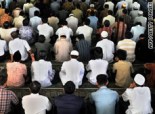 By D. Bender
By D. Bender
Latest Israeli figures show a sharp drop in the Muslim fertility rate from 4.7 children in 2000 to 3.4 in 2013, according to the Central Bureau of Statistics.
In addition, the survey, published for the Muslim Eid al-Adha holiday indicates that the growth rate of the Muslim population is slowing: from 3.8 percent in 2000 to 2.4 percent in 2013, according to Israel’s NRG News.
In comparison, the Jewish growth rate was 1.7 percent, the Druze: 1.5 percent, and the Christian: 1.6 percent.
Some 37.2 percent of the Muslim population is aged 14 and under (approximately 528,000) and only 3.7 percent is aged 65 and older (about 52,000).
The data also revealed that more than half of the Muslim population is concentrated in the north (36.4 percent, and 14.1 percent in Haifa). Another 21.6 percent live in the greater Jerusalem area. The rest live in the center (11.1 percent) and in the southern region (15.7 percent). Only 1.1 percent live within Tel Aviv.
The largest city for Muslim residents is Jerusalem, home to about 296,ooo, constituting 20.8 percent of all Muslims in Israel and 36 percent of the total population of the city.
Rahat, near Beersheba has the highest concentration of Muslims, with a population of some 59,000 residents, some 99.8 percent of the total. Other communities where there is a high concentration of Muslims are Nazareth with 52,000 and Umm al-Fahm with 51,000.
In 2012 about 10,800 Muslim couples tied the knot. On the other hand, that same year, 1,800 couples divorced. In 2012, the average marriage age of first marriage Muslim grooms (26.4) was lower than the marriage in other religions (Jews: 28.0, Christians and Druze: 29.9 and 28.1, respectively). That same year, the average first marriage age of Muslim women (21.9) was lower than the other religions (Jewish: 25.9, Christian and Druze: 25.4 and 23.2, respectively).
The average Muslim household contains 5.0 persons, higher than Jewish households (3.1) and Christian (3.2). In Israel, there are approximately 272,000 Muslim families. Most are composed of a couple with children, with at least one child under the age of 17 (67 percent); nine percent are couples without children; about six percent are single-parent families with children, the youngest of which is up to 17.
In light of the Eid al-Adha holiday, President Reuven Rivlin made a festive visit to the northern Israeli Arab town of Kafr Yasif, according to his office, and joined with hundreds of participants, among them local Arab mayors, religious and community leaders, judges and academics.
“Within this festival, there are symbols and principles that connect us as the children of Abraham, alongside symbols that express the uniqueness of each religious community. For example, the biblical Binding of Isaac, a story of standing before God, a story about the struggle between sacrifice and the sanctity of life, a story that is a seminal for Jews, Christians and Muslims,” Rivlin said.
“Indeed, the sanctity of these days, is commemorated by Muslims and Druze alike, and as it has fallen this year, for Jews, as now is the Ten Days of Repentance concluding with Yom Kippur. As with any meeting of worlds, the coincidence of these holidays, this year, has all the ingredients to be a source of friction, just as it offers every reason to be used as an opportunity to repair, and a make a fresh start.
“In recent days, I have also recognized a new positive trend. I am starting to see a little light, after the difficult and painful summer we have endured, and perhaps precisely resulting from the sense of urgency that prevailed,” Rivlin hoped.
“In recent days I have read, heard and learned that in Lod, Ramle, Haifa, Jaffa, Akko, and other places, residents along with community leaders and mayors, local religious leaders, social activists, Jews, Arabs, of different beliefs and from different ends of the spectrum, are trying to come together to find a common path. I see how slowly but surely, people are beginning to stand up across communities, first a few, and then by the dozen, to say ‘enough is enough,’
“We must take the reins, we have the keys. Responsibility for our own fate, our future, and our community life lies in our hands, indeed upon our shoulders,” Rivlin said.
{Matzav.com Israel}












Kein yima’atu!
So Tel Aviv is the most Jewish city in Israel?